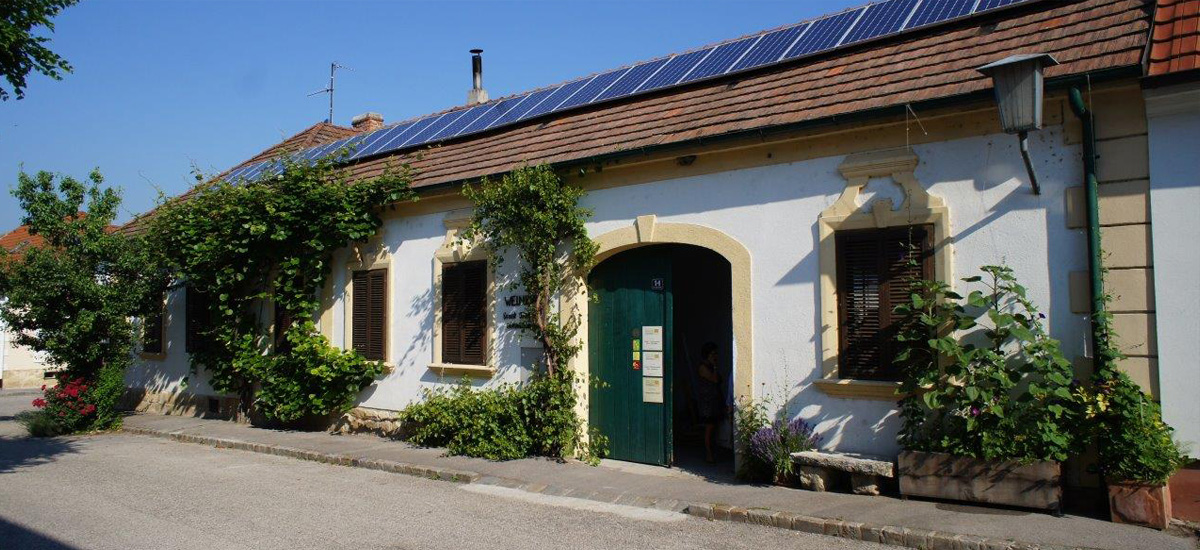The winery is located in the free town of Rust in the wine-growing region of Leithaberg in Burgenland (Austria). The traditional family has been based here for 300 years. The business was taken over in 1971 by Ernst Triebaumer, who is considered one of the "fathers" of the "Austrian red wine miracle". Since 2001 it has been run by his sons Herbert and Gerhard Triebaumer. The farm philosophy is "ecologisation in viticulture" and "wines as an antithesis to the mainstream". Through an unconventional, holistic and grandchild-friendly system, all concerns of wine production, marketing and personal lifestyle are taken into account. The environmentally friendly energy supply is provided by photovoltaic systems. The vineyards cover 20 hectares in the Gmärk, Mariental, Mitterkräftn, Oberer Wald, Bandkräftn and Vogelsang vineyards. The majority of these slope towards the lake and benefit in the morning from the sun rising on the opposite shore and the rays reflected from the lake. The northern part has calcareous to calcareous soils. The southern part is formed by crystalline weathered soils (mica schist, gneiss, quartz) with some clay.

They are 75% planted with the red wine varieties Blaufränkisch, Cabernet Sauvignon and Merlot, and 25% with the white wine varieties Chardonnay, Sauvignon Blanc, Grüner Veltliner, Welschriesling, Gelber Muskateller, Furmint and Traminer. Since the beginning of the 2000s, the vineyards have been cultivated according to the guidelines of biodynamic viticulture; from 2023 onwards, they will be cultivated according to the certified rules of the DEMETER organic winegrowers' association. Sheep are kept in the vineyards all year round and are responsible for mowing, trunk cleaning, fertilising and even defoliation. Artificial irrigation and the use of artificial fertilisers, herbicides and insecticides are avoided. The humus balance is positively influenced by species-rich cover crop and the spreading of rotted straw or reeds. The environmentally friendly confusion method is used to control the grape berry moth. Another criterion for the highest quality is physiologically ripe grapes. Harvesting is done by hand, with the grapes being selected into up to three fractions while still on the vine.
The flagship of the house is the "Blaufränkisch Mariental", which is only available in special years (not 1995, 1996, 1998). It is predominantly matured in new 300-litre barrique barrels. Starting with the 2000 vintage, barrel ageing was extended to 22 to 23 months. Other premium wines are "Blaufränkisch Gmärk", "Blaufränkisch Oberer Wald", "Chardonnay Pandkräftn" and "Sauvignon Blanc Vogelsang". Since the 2003 vintage, there is the cuvée "Tridendron" (Merlot, Blaufränkisch, Cabernet Sauvignon). The original name Tridendron (Tri-tree) is the family name in ancient Greek. In years with suitable weather conditions, sweet wines such as Auslese, Beerenauslese, Ruster Ausbruch and Eiswein are also produced. Since the 2009 vintage, sulphur-free wines have been produced from vines up to 60 years old under the "Urwerk" series. Around 100,000 bottles of wine are produced annually. Around half of the production is bottled with the Vinolok closure system. The winery is a member of the Cercle Ruster Ausbruch and Renommierte Weingüter Burgenland associations.
Voices of our members

The Wine lexicon helps me to keep up to date and refresh my knowledge. Thank you for this Lexicon that will never end in terms of topicality! That's what makes it so exciting to come back often.
Thorsten Rahn
Restaurantleiter, Sommelier, Weindozent und Autor; Dresden